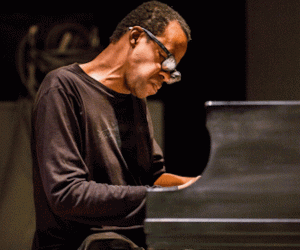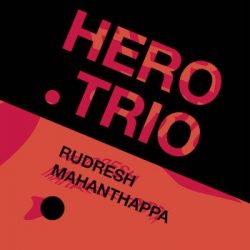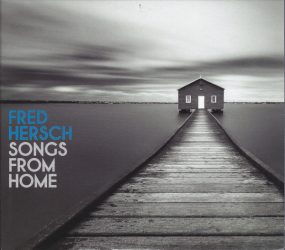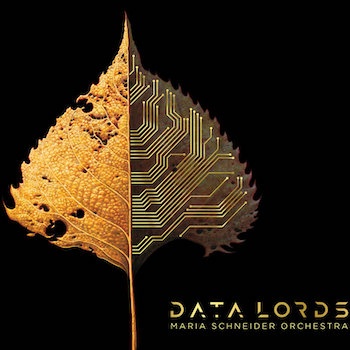Arts Feature: Significant Jazz Experiences, 2020
Compiled by Bill Marx
The magazine’s jazz critics look back over the past year and highlight their favorites — performances, recordings, and books.
Steve Elman
I couldn’t possibly hear or assess all the wonderful music released in recorded form or played online in any year, much less this one. These are simply things that particularly struck my ear and my eye in 2020.
Significant performances:

James Carter in performance. Photo: Chris Wurm.
James Carter (ts / as / stritch) Organ Trio, w. Gerard Gibbs (org), Alex White (dm), streamed live from the Blue Note, NYC, October 1. Even without a new CD or a local gig this year, Carter favored the lucky with this live performance featuring his rock-solid working band, which relies on the instrumentation of the classic organ trio but does much more. Carter is a monster, and he was once again stupendous on this night (Fuse appreciation here). Gibbs is a genuinely independent voice on his instrument – in seconds, you forget Jimmy Smith and Richard “Groove” Holmes. Alex White has proven to be the perfect complement to them, strong but sensitive. A highlight of the performance was the premiere of Carter’s new suite, a work in progress called “Entering Covidia.” This showcased all the skills of the trio in a topical frame, and Carter no doubt has ambitions to finish it when we all emerge from our caves. The set also included some of Carter’s clever reworkings of Django Reinhardt material, a revival of a tune by Rahsaan Roland Kirk, and a version of Billy Strayhorn’s “A Flower Is a Lovesome Thing” with a backbeat that put the tune firmly in my head for all the months since the show.
The most revelatory hour of music I spent in 2020 was a concert by the Contemporary Improvisation Department of the New England Conservatory called “Lost Voices,” originally streamed on November 30. The nine pieces in the program, all performed by extraordinarily talented students of the CI department, provided great aesthetic experiences in and of themselves, but also gave people as yet unaware of the riches offered at NEC a compact introduction to a resource here in our own community that is theirs for the listening.
Highlights: Sarah Matsushima’s performance of Germaine Tailleferre’s song “La rue chagrin” [“Sorrow Street”], with beautiful piano accompaniment by Avi Randall; Caleb Duvall’s arrangement of “Paralyzed” by the Legendary Stardust Cowboy (the Captain Beefheart of country music) with Kaia Berman Peters’s vocal and G North-Rockwell’s banjo; guitarist Rihards Kolmanis’s realization of an “extended technique” piece by Bjorn Fongaard; and four superb vocalists – Litha Ashforth, Gabriel Soileau, Isabel Crespo, and Delfina Cheb Terrab – in songs from Yiddish folk music, Macedonia, Iran, and Argentina.
It is available for online listening here. The stream is accompanied by extensive background information, texts, and translations, which fully complete the experience.
Significant books:
Duncan Heining, Stratusphunk: George Russell, His Life and Music (Jazz Internationale). A comprehensive revision of a landmark in jazz literature. Fuse author interview and appreciation here.
Jeff Gold, Sittin’ In: Jazz Clubs of the 1940s and 1950s (Harper Design). A sumptuous coffee-table book that celebrates the distinctive vibe of the jazz club in its heyday that should help assuage the withdrawal pains of Covid Time. Gold gets right the camaraderie of the musicians, the atmosphere, the celebratory nature of the club experience, and the Black-white mingling in those tiny temples of music. It’s decorated lovingly with candid photos and reproductions of the now-long-gone souvenir folders that used to be a requirement of any club worth its name. The book is NYC-centric, of course, and the tiny Boston section spotlights the North Adams Armory (really?) instead of Storyville, but it still represents a major step in jazz scholarship. Fuse review
A significant digital release:
 Ben Perowsky: Upstream, w. Chris Speed, ts/cl; John Medeski, org
Ben Perowsky: Upstream, w. Chris Speed, ts/cl; John Medeski, org
Available in single tracks or as a digital album here on Perowsky’s Bandcamp site.
Here’s another way to reimagine the organ trio. If James Carter is defining new territory in the genre with energized traditional repertoire, drummer Ben Perowsky’s Upstream is a convincing adventure in avant-bop. Chris Speed is a thoughtful searcher on saxophone, not at all like the full-throated tenor players who usually front organ trios. This puts the weight of the band on the organist’s shoulders, and that’s what makes this date something of a revelation. Medeski takes off his jam-band hat to dig into real solos with real structure, showing a welcome debt to the late Khalid Yasin. On track after track, he intensifies and enriches, sometimes by taking traditional effects and pushing them harder, sometimes with dramatic shifts of volume, always with powerful bass-pedal facility that adds punch just when it’s needed. Speed is also heard to excellent effect on clarinet, especially on “Worms.” The drummer is content to lead from behind the traps for the most part, but he is always colorfully present.
Four satisfying guitar CDs:
John Scofield: Swallow Tales (ECM), with Steve Swallow, b; Bill Stewart, dm
Hearable on Spotify.
Here is the John Scofield I’ve always loved, the smart soloist and guitar original, just playing them tunes, in this case a full program of Steve Swallow originals. The trio jumps into the improv sections as if they can’t wait to mix it up. Fuse review here.
Susan Alcorn: Pedernal (Relative Pitch), w. Mary Halvorson, g; Mark Feldman, v; Michael Formanek, b; Ryan Sawyer, dm
Hearable on Spotify.
This CD lets us hear two of the most interesting guitarists on the scene at the same time, and the combination is bracing. Pedernal is doing what should have been done long ago – she has unleashed the pedal steel from the Nashville corral and turned it loose to ride on the open prairie, although she knows exactly when to rein it back to the melody trail. And Mary Halvorson proves with every note that there’s still a lot more that can be done with that good old electric six-string, especially when you add some interesting effects and out-of-the-box technique. Both women let their instruments slip and slide around one another in adventurous ways, with a collective sound that is consistently fascinating. You might start your listen with “Night in Gdansk,” because it is the most “conventional” tune in execution, with actual solos by the three lead voices and bassist Michael Formanek.
Pat Metheny: From This Place (Nonesuch), with Gwilym Simcock, p; Linda May Han Oh, b; Antonio Sanchez, dm
Hearable on Spotify.
Is Pat Metheny really 65? The youth of his music (and its unabashed Midwestern open-heartedness) is undiminished, perhaps even refreshed, in this CD, his first since the death of Lyle Mays. Notably, the cover does not say “Pat Metheny Group,” and perhaps that means he has decided to turn the page on that part of his life. The repertoire is not surprising, but it is very well balanced, including another of Metheny’s multifaceted suites (“America Undefined”), 13 minutes of shifting atmospheres and occasional sound effects that accomplish more in this space than Metheny has previously been able to do in much bigger frames. The CD’s orchestral sweetening is not exactly enriching, and there are moments when you might ask the music to push into more adventurous territory. But From This Place is top-drawer Pat Metheny, and that’s enough.
Bill Frisell: Valentine (Blue Note), with Thomas Morgan, b; Rudy Royston, dm
Hearable on Spotify.
This is the first recording Frisell has made with just his trio – bassist Royston and drummer Morgan. It also has one of the most balanced menus ever on a Frisell CD. The recording is superlative, the rapport is admirable, the musicianship is a delight, and the feel as comfortable as that of an old pair of jeans. Fuse concert and album review here.
Three great brass CDs:
 Jeremy Pelt: The Art of Intimacy, Vol. 1 (HighNote) w. George Cables, p; Peter Washington, b
Jeremy Pelt: The Art of Intimacy, Vol. 1 (HighNote) w. George Cables, p; Peter Washington, b
Hearable on Spotify.
This excellent trumpeter has been showcased often (and been seen in Boston in the last couple of years) in the cooperative band called the Black Art Jazz Collective, where his tunesmithing has been impressive, but here he has the accompaniment of only two players, each of whom is a talent of the first rank. The results are time-stand-still inspiring. The menu is mostly ballads, nearly all of them neglected tunes, and they show the breadth and self-assurance that always were just beneath the surface in Pelt’s other performances. He is so good on these sides that you’ll want to look up the lyrics to the tunes so that you can appreciate the real beauty in his wordless singing. The set is balanced by two duets – one with Cables, on his own “Ebony Moonbeams,” where Pelt makes the most of a little lope in the rhythm, and the other with Washington, on a head blues they call “Ab-o-lutely,” where Pelt pays homage to the Miles Davis of the late 50s, reinforced by a little old-fashioned reverb close to that used by Miles’s engineers way back when.
Ron Miles: Rainbow Sign (Blue Note), with Jason Moran, p; Bill Frisell, g; Thomas Morgan, b; Brian Blade, dm
Hearable on Spotify.
Miles is 57, and midlife clearly agrees with him. This CD is the definitive statement of an artist very much in his own voice. His axe is the cornet, the instrument of searchers, its sound a bit sharper (in both senses) than the trumpet, but that’s perfectly appropriate here. In the first minutes of listening, you think, “This is pleasant,” but as tune after tune deepens this programless story, you realize that Miles has created something special. It is both searching and thoughtful, and the finale, “A Kind Word,” surprises because it goes in exactly the direction you don’t expect – it brings things to a satisfying resolution without being a flag-waver. Miles is never the incontrovertible star of this band of generals (a Blue Note band for today), but he exerts his leadership through eloquence. Even more impressive is that this is a working band, not a producer’s concept.
Ambrose Akinmusire: on the tender spot of every calloused moment (Blue Note), with Sam Harris, p, syn; Hamish Raghavan, b; Justin Brown, dm; Jesus Diaz, vo, per; Genevieve Artadi, vo
Hearable on Spotify.
Akinmusire, now 38, has made five CDs before this one, each one more assured than the last. This one is another step forward for him, a mature, often reflective set from an artist who says something with every note. His approach is strongly vocal – at times conversational, at times singing, sometimes even in a choked keening at the top of his range. He has also developed a personal collection of effects that broaden the traditional trumpet arsenal, drawing on Lester Bowie, Don Cherry, and even reaching back to the great half-valvers like Ray Nance. His writing is intuitive and sinuous, and there is a usually a heartline of melody, which he often emphasizes by having pianist Sam Harris double his lines. The frameworks here are freeish, though a regular pulse anchors every tune.
Three beautifully intimate vocal CDs:
 Ran Blake and Christine Correa, When Soft Rains Fall (Red Piano)
Ran Blake and Christine Correa, When Soft Rains Fall (Red Piano)
Hearable on Correa’s bandcamp site
Ran Blake has made many dramatic recordings with singers, including landmarks with Jeanne Lee and Dominique Eade. Lately, he’s been working with Christine Correa, and the partnership is proving fruitful. This new CD is among his most memorable, particularly significant because it is an album-long tribute to one of Blake’s goddesses, Billie Holiday. Nearly all the repertoire is drawn from Holiday’s last session, “Lady in Satin.” Blake is still the great master of space and atmosphere, and Correa has the kind of control that is absolutely necessary when the accompanist is playing “against the changes,” as he often does. Correa also can add grit to her lovely sound that colors words with great intelligence. Throughout, the material is stripped down to its raw essence, and singer and pianist give every second an edge-of-your-seat intensity. A notable and uncharacteristic highlight: in “Lady Sings the Blues,” Blake’s accompaniment is only a dark modal strum on the low piano strings that challenges Correa’s ability to sing on pitch.
Kurt Elling, Secrets Are the Best Stories (Edition), with Danilo Pérez, p
Hearable on Spotify.
Elling has extended the idea of “song interpretation” into a deeply personal space. The words here are not the lyrics of classic popular songs, but poetic texts by Franz Wright, Robert Bly, Toni Morrison, Oscar and Valeria Martinez-Ramirez, and Elling himself. They are set to music, almost all Elling’s own, that sounds at one moment carefully prewritten and at the next completely improvised. Some songs are tales passionately told. Others, like Elling’s own “Stages,” are mood pieces that paste image upon image for collective effect. The core of the CD has the austerity of a vocal-piano recital, but the occasional enhancements – bass, drums, Latin percussion, prepared piano, electric keyboard, elegant Spanish on “Rabo de Nube,” and layered harmony vocals (all in Elling’s voice) enrich without distorting the purity. Pianist Danilo Pérez is indispensable to the success of the performances. The theme of this CD is the title itself.
Norma Winstone and John Taylor: In Concert (Enodoc, 2019)
Hearable on Spotify.
This absolutely exquisite recital came out late in 2019, but I didn’t hear it until 2020, so I’ve taken editorial liberty to include it here. The partnership between Norma Winstone and the late John Taylor lasted almost five decades. At the time of this recording (1988) Winstone (then 47) still had her highest upper-register notes, which are on awe-inspiring display. Taylor is with her in every nuance, and shows his great gift for improvised melody in his solo spots. The program was put together at almost the last minute, which makes the rapport and depth all the more remarkable. Highlights: Winstone’s witty lyrics on Steve Swallow’s “Ladies in Mercedes”; a perfect pairing of Thelonious Monk’s “’Round Midnight” and Lionel Hampton’s “Midnight Sun”; an unbridled romp on “The Coffee Song,” (here labeled “Coffee Time”), an ancient novelty tune whose lyric is just barely hinted at; and the ecstatic conclusion of “Celeste,” a tune by Ralph Towner. If you have never heard Winstone, hear this one.
Two remarkable CDs with master pianists:

Matthew Shipp in action. Photo: Daniel Sheehan.
Matthew Shipp: The Piano Equation (Tao Forms)
Hearable on Spotify.
Those who characterize 61-year-old pianist Matthew Shipp as a great original stylist are right – but only if you also remember his debts to Bud Powell, Ran Blake, and Cecil Taylor. Those influences are obvious, and Shipp’s honesty about them do not compromise his originality – they only show how mature an artist he is. This completely improvised solo recital is a fully realized exercise in skill and depth, amply showing his remarkable sense of organization, his intelligence, and his well-honed ability to tell a story. Each one of these 11 pieces has a distinct character, and each one is precisely balanced. Fuse review here.
Tim Ray: Excursions and Adventures (Whaling City Sound), w. Terri Lyne Carrington, dm; John Patitucci, b
Hearable on Spotify.
Just because he makes his home in our area and plays here often doesn’t mean Tim Ray should be underestimated. He is one of the smartest musicians around, but he never wears his brain on his sleeve. This CD gives us the best recorded example of the richness of his talent so far, and for pure listening pleasure, it is hard to beat. It’s a mark of the respect Ray enjoys from his fellow musicians that Terri Lyne Carrington and John Patitucci, both leaders in their own right, contribute so cooperatively here. The range of the repertoire on this CD is wide, and Ray finds ways to make every track convincing. One example: his ingenious arrangement of the Jagger-Richards “Paint It, Black,” shaded by a hint of classical counterpoint, plumbs the real meaning of the song – desolation (and suppressed anger) when a lover dies
The most recent work of two great composers:
Carla Bley: Life Goes On (ECM), w. Andy Sheppard, ts; Steve Swallow, b, Hearable on Spotify. The third part of Bley’s marvelous trio triptych. Fuse review and appreciation here.
Maria Schneider & Orchestra: Data Lords (artistShare) An uncompromising artist delivers an uncompromising magnum opus. Fuse review and appreciation here.
And a partridge in its own pear tree:

Marshall Allen (l) and the Sun Ra Arkestra in costume and in performance.
Sun Ra Arkestra, led by Marshall Allen (as / EVI): Swirling (Strut), w. Danny Ray Thompson, bari / fl; Michael Ray, tp; Vincent Chancey, Frh; Dave Davis, tb, vo; James Stewart, ts / fl; Farid Barron, kb; Dave Hotep, g; Tyler Mitchell, b; Wayne Anthony Smith, Jr., dm; Tara Middleton, vo
Hearable on Spotify.
God bless 96-year-old Marshall Allen. He has lived to direct the first perfectly recorded – and possibly the best-played – studio session in the more than six decades of the Sun Ra Arkestra. This is a release to own if you love Sun Ra. This is also the one to own if you have never heard Ra and want to begin to understand his wonderful universe of weirdness. Ra came out of the swing tradition, and began leading his own big band in the 1950s. His Arkestra eventually included singers, dancers, and fire-eaters, many of whom lived collectively with Ra in Philadelphia. Ra’s work was always on the fringes of the jazz world, resolutely going its own way with “music from outer space” built around the leader’s acoustic and electric keyboards. A Sun Ra show might range from rough-and-tumble recreations of big band material to completely unstructured music, all performed either in a frame of mind that was disconnected from reality or tongue-in-cheek, depending on the listener’s point of view. Swirling shows it all – early space gems (“Angels and Demons at Play”) 70s psychedelia (“Astro Black”), a space anthem (“Door of the Cosmos”), out music (“Infinity”), a big-band blues (“Space Loneliness”), and even a loose-jointed version of Coleman Hawkins’s “Queer Notions,” arguably the first deliberately weird composition in jazz history. Allen is still eloquent in his alto solos, which is remarkable in itself, but he has also found a pianist who can adequately fill the founder’s moon boots, the outstanding Farid Barron. Ra is gone, but he must be smiling somewhere out among the celestial orbs.
Steve Feeney’s Ten Best (in no particular order)
 Rudresh Mahanthappa – Hero Trio (Whirlwind)
Rudresh Mahanthappa – Hero Trio (Whirlwind)
The recording company’s name for this release says a lot. Saxophonist Mahanthappa can blow open songs without blowing them up. Classic material is at the vital center of this powerful disc. Fuse review
Thumbscrew – The Anthony Braxton Project (Cuneiform)
Another strong trio effort, this one inspired by the complex and fascinating compositions of teacher/mentor/former bandmate Anthony Braxton. Fuse review
James Brandon Lewis Quartet – Molecular (Intakt)
Saxophonist Lewis has hit back-to-back homers with this disc and his previous album. His energy takes you by surprise — even when you feel it coming.
Tani Tabbal Trio – Now Then (Tao Forms)
Long-respected drummer Tabbal releases a richly recorded trio disc that’s not quite easy listening — but is nonetheless easy to appreciate.
Kenny Barron/Dave Holland Trio – Without Deception (Dare 2 Records)
Veteran collaborators who show you what smooth and swinging is all about on a master level. Arts Fuse review
Tomas Fujiwara – 7 Poets Trio (RogueArt)
Drums/cello/vibes, all on a mission to penetrate the core of avant-jazz.
Maria Schneider Orchestra – Data Lords (ArtistShare)
Schneider is among those hailed as “important” composers whose work rewards casual listening. She has come up with a major big band recording that deserves lots of attention, and not only by critics. Arts Fuse review
 Fred Hersch – Songs from Home (Palmetto)
Fred Hersch – Songs from Home (Palmetto)
The superb pianist sat at home early in the pandemic and sunk his soul into these soothing but far from simple solo performances.
Rich Halley – The Shape of Things (Pine Eagle Records)
Halley knows that the life force of avant-jazz comes from a churning cauldron of energy. This veteran quartet taps into it and flies over the edge. Fuse review
Ron Miles – Rainbow Sign (Blue Note)
Feels a little psychedelic, but in a good way. The album moves beyond laid-back mellowness by way of its amazing musicianship.

Allen Michie
The Maria Schneider Orchestra, Data Lords (ArtistShare). Composer and arranger Schneider not only asks challenging questions about our dependency on invasive technology, she also takes the difficult next step of providing answers. In a jazz world still dominated by head-solos-head, this is music with intention, perspective, and lyrical beauty. Fuse review.
Michael Ulman
Best jazz records of 2020
Many of these recordings were made before the arrival of the pandemic; nonetheless, it was an excellent year in recorded jazz. I’ve listed in alphabetical order some of the issues that have pleased me most. In recent months there has been an outpouring of “lost” or neglected sessions.I have listed six of those.
Ambrose Akenmusire, On the Tender Spot of Every Calloused Moment, Blue Note
Kenny Barron and Dave Holland Without Deception, DARE 2 (Fuse review)
Dave Brubeck, Lullabies, Verve
Dave Douglas and Elan Mehler with Dominique Eade, If There Are Mountains, NEWVELLE LP (Fuse review)
Bill Frisell and Thomas Morgan, Valentine, Blue Note (Fuse review)
Mary Halvorson’s Code Girl, Artlessly Falling, Firehouse 12 (Fuse review)
Fred Hersch, Songs from Home, Palmetto
Rudresh Mahanthappa Hero Trio, Whirlwind (Fuse review)
Maria Schneider, Data Lords, ArtistShare (Fuse review)
Historical issues
Art Blakey, Just Coolin’, Blue Note
Bill Evans, Live at Ronnie Scott’s, Resonance
Ella Fitzgerald, The Lost Berlin Tapes, Verve
Charles Mingus at Bremen, 1964 and 1975, Sunnyside
The Complete Hank Mobley Blue Note Sessions, 1963-70, Mosaic
Sonny Rollins, Rollins in Holland, Resonance

Such wonderful, provocative lists.